A Summer of Sampling with the Byrnes Lab!
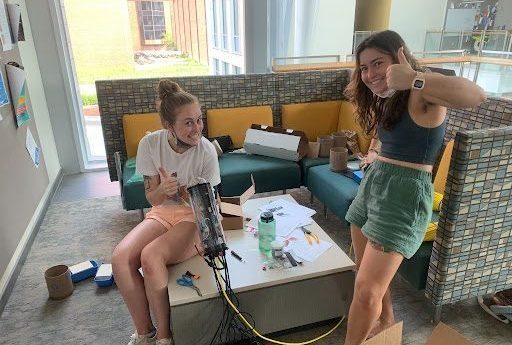

By Laura Dissly
So you’ve decided to invest in “shore-based climate adaptation solutions” on multiple islands in the Boston Harbor over the next 5 years – GREAT! But what are the first steps to make that happen?
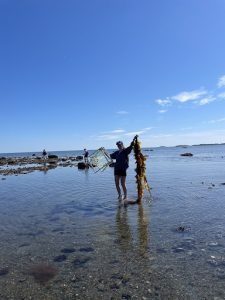 Firstly, what exactly is a shore-based climate adaptation solution? As sea level rises, coastal cities like Boston are going to be more prone to flooding. Typically we think of protecting urban shorelines with seawalls or other gray infrastructure, but what if we paired gray infrastructure with green infrastructure like artificial reefs or seagrass beds? Bringing these two types of coastal protection systems together is what the Stone Living Lab is trying to do on the Boston Harbor Islands.
Firstly, what exactly is a shore-based climate adaptation solution? As sea level rises, coastal cities like Boston are going to be more prone to flooding. Typically we think of protecting urban shorelines with seawalls or other gray infrastructure, but what if we paired gray infrastructure with green infrastructure like artificial reefs or seagrass beds? Bringing these two types of coastal protection systems together is what the Stone Living Lab is trying to do on the Boston Harbor Islands.
And secondly, you’d probably want to start by hiring a couple lab techs, investing in some PVC and setting your alarm clock for 4am.
Part 1: Intertidal Shenanigans
2021 was the Stone Living Lab’s first year working on the harbor islands. Before any experiment can start, you need to collect baseline data to find out the current conditions along the shore. That’s where we at the Byrnes Lab come in! First things first, we started by figuring out what kind of data we were going to collect and how we were going to collect it. After a couple weeks of hashing out protocol details, unearthing a collective dread of Fucus (brown algae), conducting species differentiation (Fucus spiralis and Fucus distichus can have very similarly shaped fronds and receptacles), and several trips to Home Depot, we were ready to get those alarm clocks set and identify some organisms! For our first field days, we focused on intertidal species – critters that live in the area that gets covered at high tide. Here’s a insider-view of what our field days looked like:
Day 1 in the field: Rainsford Island – Intertidal turns subtidal
Highlights from our first collection day included a departure time of 4am, racing the tide to complete our surveys, a sunrise that made getting up at 3am almost bearable, and more Fucus dread. Onward and upward.
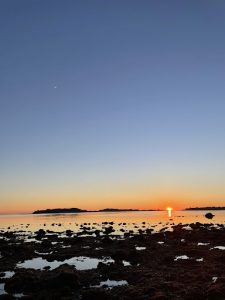 Day 2: Peddocks Island – Bivalvia galore
Day 2: Peddocks Island – Bivalvia galore
On our second day, we surveyed the intertidal of Peddocks Island, where we were greeted by thousands of mussels and a lovely 5am rainstorm. But we persevered!
Days 3 and 4: Gallops and Georges – What day is it again?
Our last two days of intertidal data collection were relatively uneventful compared to our first two days, hence the lumping of them into a group. Lots of Mastocarpus (a red algae that branches similarly to a bush or tree), still a good amount of confusion about the difference between Fucus distichus and Fucus spiralis, snails out the wazoo… you get the picture.
Part 2: How many biologists does it take to build a robot?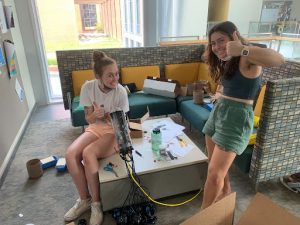
With intertidal sampling done, we shifted our focus to subtidal sampling – finding and counting the creatures that live fully underwater around the same four islands. Easy peasy (minus the fact that: the lab ROV needed to be replaced, the replacement we bought arrived unassembled, Boston Harbor isn’t exactly known for having the clearest water, and the currents that whip around the islands). So back to the question at hand: how many biologists does it take to build a robot? According to the Byrnes lab, 3-4 as long as YouTube University, Bahn mi, and coffee are provided. After several arduous hours of ROV construction, the newest member of the Byrnes lab, C-Thax 2, came to life!
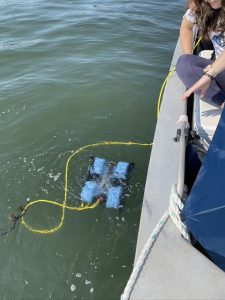
On the day of C-Thax 2’s maiden voyage, we boated out to Rainsford, said a prayer to her namesake (Celia Thaxter – may she have mercy on our souls) and held our breath as we put several thousand dollars’ worth of electronics into the Boston Harbor. One 40 meter transect later we hauled her out of the water unscathed and ready for her second deployment.
Since her inaugural dip, the C-Thax 2 has required a couple spa days and tune ups, but who doesn’t need a little R&R and TLC after a summer of sampling?
As the summer comes to a close, we still have a couple of islands left to collect subtidal data from, but are now moving onto data processing – at least until next summer when we will do it all again after some new green/gray infrastructure installation.